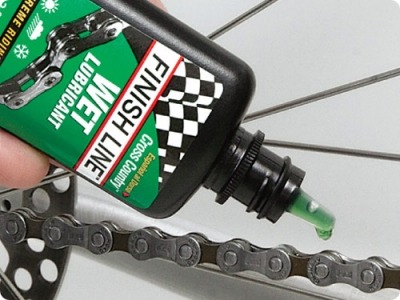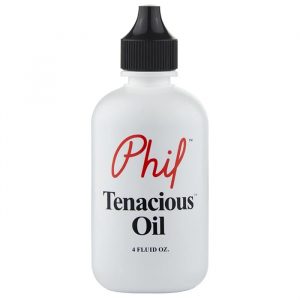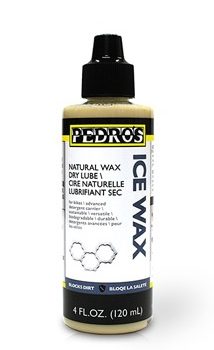Von Collins is an accomplished triathlete and endurance cyclist, and the author of four fitness and training books: Smarter Running, Your First Triathlon Guide, Fit Foods, and 30 Rut-Busting Workouts. He has been cited as a triathlon, cycling, and fitness expert by Healthline, CNET, Forbes, Eat This, Not That and other major outlets.
Bike chain lube is a vital part of cycling. If there are only two things you do regularly, you need to oil the chain and keep your tires inflated. Those two things will solve a large chunk of possible cycling maintenance issues.
The good news is that oiling or lubing a bike chain is pretty darn easy. You can use many types of high-performance bike chain lubes, or many multi-purpose oils. Even good old WD40 is still widely used and debated by cyclists, even though it’s more broadly recognized as a household quick fix than as a bike shop staple.
We recommend you use a good bike repair stand because it puts the bike at eye level, and is just a whole lot more comfortable to work and do a good job without crouching down. The Park Tool PCS 10-3 is an example of a stand we like.
Now, some bike lube basics.
What is Bike Lubricant For?
 Chains receive more attention than any other part of the bike when discussing lubricants, and for good reason. Chains can fling gritty muck all over the place when dirty, they audibly grind and squeak when dry, and they tend to rust faster and more severely than other parts of the bike. These annoyances are clues about chain lube’s main jobs: cleaning, lubrication, and corrosion resistance.
Chains receive more attention than any other part of the bike when discussing lubricants, and for good reason. Chains can fling gritty muck all over the place when dirty, they audibly grind and squeak when dry, and they tend to rust faster and more severely than other parts of the bike. These annoyances are clues about chain lube’s main jobs: cleaning, lubrication, and corrosion resistance.
Cleaning might be chain lube’s most easily misunderstood job. Plenty of products are more focused on, and effective at, cleaning serious muck and grit out of a chain. Most people will turn to these degreasers and cleaners for chain cleaning, since they only see a chain as dirty once a significant amount of material has built up on top of the chain. However, it’s contamination inside the chain’s tiny pins and rollers that harms a chain, not buildup outside its links. Chain lube helps clean these contaminants off and away before they do harm: lubricant takes up space between parts to keep unwanted material out, and re-applying lube washes these areas clean.
Lubrication is more broadly understood but can still be less intuitive than expected. Chain links riding on gears are creating metal-on-metal contact, and lubrication can help lower the friction at these contact points. However, as we discussed with respect to cleaning, it’s the chain’s small pins and rollers where the magic of motion happens. For that reason, lubricants aren’t necessarily reducing friction between chains and gears as much as between parts of the chain itself. While the difference may seem minor, it’s critical for one reason: chains and gears wear out, but that’s not necessarily because of lubrication. In fact, using more and more lubricant to try to avoid gear and chain wear can be counterproductive.
That leaves corrosion resistance, chain lube’s simplest job. From the very first bike chain to the newest, virtually every link, roller and pin are steel. Even corrosion-resistant stainless steel is unusual, so the vast majority of chains are prone to corrosion. How corrosion-prone can vary, but any source of moisture from airborne humidity to rain-filled potholes can set a chain on its way to rusty demise. The addition of salt, from seaside or ice-prone environments, is especially damaging to chains. In contrast, chain lubes do not corrode chains, so stick them in between the chain and water and problem solved.
Types of Bike Chain Lube
Walk into any bike shop, or navigate to any online store, and you’ll notice right away that “chain lube” is more of a category than a specific product. You might even find products that are chain lubes according to some, but not according to others: WD40 is one example, but so are bike shop staples like Tri-Flow and Phil Wood Tenacious Oil. Why? The answer is a theme which some readers will find familiar: it depends. Because chain lube does so many jobs, there are different lubes which prioritize those jobs differently. In general, though, chain lube divides into two areas: dry lube and wet lube. Dry lube is commonly misunderstood because it’s usually sold in a bottle containing liquid. The confusion is understandable, but look closer: Many dry lubes visibly separate in the bottle, leaving both liquid and solid components which need a healthy shake to re-combine. The solid component has most of the lubricating properties, while the liquid is just a solvent. Mixing the lubricant into that solvent makes delivery to the chain much easier, compared to pasting a dry film onto a chain, and the thin solvent also helps the lubricant creep further into the chain’s moving parts. The solvent usually evaporates quickly, leaving the chain dry to the touch but lubricated with a solid film, hence “dry lube.”
Dry lube is commonly misunderstood because it’s usually sold in a bottle containing liquid. The confusion is understandable, but look closer: Many dry lubes visibly separate in the bottle, leaving both liquid and solid components which need a healthy shake to re-combine. The solid component has most of the lubricating properties, while the liquid is just a solvent. Mixing the lubricant into that solvent makes delivery to the chain much easier, compared to pasting a dry film onto a chain, and the thin solvent also helps the lubricant creep further into the chain’s moving parts. The solvent usually evaporates quickly, leaving the chain dry to the touch but lubricated with a solid film, hence “dry lube.”
Wet lube, in contrast, applies wet and stays wet. Wet lubes are also much more viscous than the solvent liquids of dry lubes, and far more stubborn: rather than evaporate, wet lube sticks to chains unless it’s wiped or blasted away. Most general purpose lubricants that see use on bike chains, such as 3-in-One oil, are considered wet lubes. Chains treated with wet lube are generally oily to the touch, and it’s usually wet lubes responsible for the telltale splatter you see on some frames and even riders’ pant legs.
Both dry and wet lubes have benefits and drawbacks. Dry lube tends to adhere much less strongly to chains, making it far more susceptible to wash away in wet weather. In fact, it’s common for bike with dry lube on the chain to squeak viciously just from spending a day locked up outside in rainy weather. Large puddles are even more effective in stripping dry lube from a chain. However, those same puddles can be the bane of wet lube: the grit carried in murky roadside water and slush is easily combined into wet lube to form a nasty, abrasive mud. If left unchecked, this muck can solidify and greatly impede performance, not to mention flung droplets contaminating everything from clothing to frames and braking surfaces. Dusty environments such as construction sites can also contribute to the issue.
The choice of wet versus dry is personal preference, but follows a simple logic: dry weather calls for dry lube, and wet weather for wet lube. Winter riding is also a case when wet lube can excel, because of the repeated dampness caused by melting snow. Expect maintenance in either case, whether frequent re-application of dry lube or routine deep-cleaning of wet lube.
Our Favorite Bike Lube or Oil For Various Situations
| Product | Description | Why We Like It | Where to Find it |
|---|---|---|---|
| Pedro's Chain Wax | A paste that lubricates your bike chain, without using oil. | Different than most oils or lubes. You apply it like you would apply wax or paste, and just leave it on your chain. Then, it works its way in. Can be applied indoors with no drippage. | |
| Finish Line Dry Lube | All-purpose bike oil and lube meant to be used mainly in dry conditions | It really is more than a chain lube, and can be your all-purpose bike oil for every moving component. Great all-around product to have stocked in your bike workbench. Doesn't great dirt clumps if excess oil is properly wiped off during application. | Here, on Amazon |
| Tri-Flow Dry Squirt Lube | Thin oil that is a favorite on chains and moving components. | Really effective in hard-to-get-places since it goes on thin. | Here, on Amazon |
| WD-40 Bike Wet Chain Lube | A reliable wet chain lube from the venerable maker of lubricants | Does an excellent job protecting against corrosion (think areas with salt water air). Tends to really clean the chain, in addition to providing some basic lubrication. | Here, on Amazon |
Why Use Bike Lubes?

With wet versus dry lube out of the way, it’s time to address the elephant in the room: Bicycle-specific lubricants are expensive. What’s to stop a cyclist from lubricating a chain with more common and affordable lubricants, whether generic spray cans or even motor oil? Our concern with chain lube washing off is a strong clue that environmental considerations are critical. After all, motor oil is at least intended to remain inside a motor, and shops and individuals alike are obligated to dispose of used oil responsibly at recycling points. In contrast, the majority of bike lubes are made it at least some ecological impact in mind, and plenty of manufacturers offer an organic “bio” option.
A fair comparison is the adage that most lipsticks and lip balms end up swallowed by their wearer: it’s no coincidence that lipsticks are fairly benign compared to the heady fumes that telegraph nail polish from the next room over. Environmental concerns have even driven a resurgence in the use of paraffin wax, one of the most inert and organic lubricants available. However, the need to remove a chain and dip it in a hot wax bath continues to limit its appeal.
Other Cycling Lubricants
Like chains, every moving part of a bicycle benefits from cleaning, lubrication and corrosion protection. For these, we like built-for-cycling lubes like Finish Line or Tri-flow bike lubes. However, few parts of a bicycle are as exposed or undergo as much force and motion as chain links, making chain lube less ideal elsewhere on the bike. Generally bearings such as headsets, wheel hubs and crank bottom brackets are packed with grease and the subject of a different conversation entirely. That leaves cables systems, once ubiquitous but less common in the age of hydraulic brakes and electronic shifting; and small pivot points, found in derailleurs and brakes. Each of these systems is designed with a form of lubrication already, such as special low-friction liners. If these parts become sticky, they are best replaced. However, the right product can sometimes eke extra miles and better performance out of older parts.
This is where we introduce our old friend WD40 back into the fold. It should be noted that WD-40 makes some bike-specific lubes (one is mentioned in our table above) but here we are talking about the general, legendary lubrication product.
WD40 offers relatively marginal lubrication, but displaces water and corrects against corrosion. Those properties are excellent for use as a pivot and cable lubricant. They also make WD40 and similar products invaluable when adding just enough lubricant to take noise but not wanting the mess of a heavier lubricant. The outer rubber dust seals of headsets, wheel hubs, and pedals are common culprits. A difficult quick release skewer and even creaky saddle rails can also benefit from the tiniest hint of lubrication. WD40 is also a moderately effective penetrating oil to free stuck bolts, screws, and even spoke nipples, but it can be safer on delicate parts or for home use than more aggressive products like PB Blaster. Just exercise caution to keep any product away from braking surfaces, particularly disc brake rotors and pads.
Other bike-specific and general purpose products exist with similar or superior properties to WD40. However, teflon (PTFE) is a common feature of many such products, and concerns over both the compound and its many manufacturing byproducts should be carefully weighed, especially with the risks of environmental contamination, substandard ventilation and lack of personal protective equipment that tend to accompany bicycle care products.
Bike Lubricant Service Schedule
The final most common question about any lubricant is how often it needs to be applied. Big surprise: it depends. However, contrary to popular belief, there is no such thing as lubricating too frequently. When mechanics stress moderation, it’s because applying too much lube can be a waste of money. In the case of wet lube, it can also accelerate the buildup of muck in a drive train. However, properly cleaning a chain and re-applying lubricant is a harmless process. If a chain is noticeably dirty, noisy, or beginning to show corrosion, it should be cleaned and lubricated no matter how little time has elapsed since its last treatment. Any guideline on frequency is arbitrary, but here’s a good starting point: clean and lube a bike chain roughly every other time the tires need inflating. For hardcore commuters and other daily riders, that might be multiple times weekly, while for weekend warriors every other week is practical. This is a good time for a gentle reminder that tire pressure should be checked before every ride, even with a simple squeeze test. Don’t be afraid to buy a gauge to settle any uncertainty.
Any guideline on frequency is arbitrary, but here’s a good starting point: clean and lube a bike chain roughly every other time the tires need inflating. For hardcore commuters and other daily riders, that might be multiple times weekly, while for weekend warriors every other week is practical. This is a good time for a gentle reminder that tire pressure should be checked before every ride, even with a simple squeeze test. Don’t be afraid to buy a gauge to settle any uncertainty.
No other part of a bike requires the same lubricant performance as a chain, since few moving parts move as constantly or are as exposed. For derailleur pivots and cables, lube symptomatically or any time they see water. Because lube has fewer places to go in these areas, over lubrication is more likely to cause issues. The worst case scenario for these parts if they are neglected is usually replacement, and in most cases even diligent lubrication only delays eventual replacement.








There are chain lube alternatives you can use, such as chainsaw oil, to prevent corrosion. Clipper oil is odorless and anti-rust. I use silicone spray because it’s quick to dry and is non-toxic. The slipperiness of this substance also allows it to penetrate derailleur and spring pivots easily.
Chainsaw oil, Silicone Spray, Clipper Oil, and 3-in-1 Oil are the recommended lube alternatives that you can use for your bike chain. You must avoid oils that are overly thick. Petroleum jelly, cooking oil, olive oil, and coconut oil should also be avoided as a lubricant alternative.
If you ride in a dusty environment such as California, this bike chain lube from Finish Line is the only option. I use this on my downhill bike at Northstar and my road bike on the trails. After every ride, I recommend rinsing the transmission and chain. You will find that the dust just washes away without leaving grease like other chain lubricants. Reapply after rinsing and drying. This is how I keep my bike running smoothly in the CA dust.